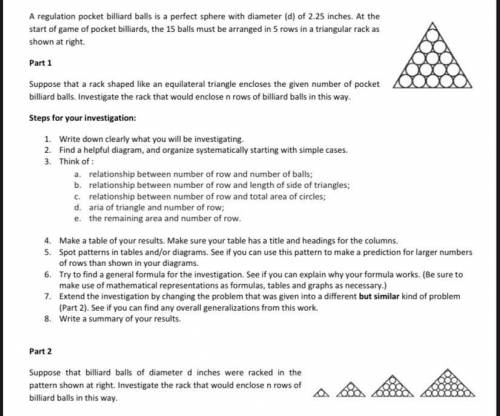A regulation pocket billiard balls is a perfect sphere with diameter (d) of 2.25 inches. At the start of game of pocket billiards, the 15 balls must be arranged in 5 rows in a triangular rack as
shown at right.
Part 1
Suppose that a rack shaped like an equilateral triangle encloses the given number of pocket
billiard balls. Investigate the rack that would enclose n rows of billiard balls in this way.
Steps for your investigation:
1. Write down clearly what you will be investigating.
2. Find a helpful diagram, and organize systematically starting with simple cases.
3. Think of:
a. relationship between number of row and number of balls;
b. relationship between number of row and length of side of triangles;
C. relationship between number of row and total area of circles;
d. aria of triangle and number of row;
e. the remaining area and number of row.
4. Make a table of your results. Make sure your table has a title and headings for the columns.
5. Spot patterns in tables and/or diagrams. See if you can use this pattern to make a prediction for larger numbers
of rows than shown in your diagrams.
6. Try to find a general formula for the investigation. See if you can explain why your formula works. (Be sure to
make use of mathematical representations as formulas, tables and graphs as necessary.)
7. Extend the investigation by changing the problem that was given into a different but similar kind of problem
(Part 2). See if you can find any overall generalizations from this work.
8. Write a summary of your results.
Part 2
Suppose that billiard balls of diameter d inches were racked in the
pattern shown at right. Investigate the rack that would enclose n rows of
billiard balls in this way.

Ответы
Показать ответы (3)
Другие вопросы по теме Математика
Популярные вопросы
- Тапсырма мә7: Егер OM сәулесі АОВ бұрынын как болсе, ал ОК сәулесi AOMI бұрышын...
3 - Звуки природы Средства музыкальной выразительности необходимы для:настройки...
3 - 3 Ergänzen Sie die Verben im Präteritum.I Der König...... eine Tochter und...
2 - «Аяз би» ертегісінде айтылатын құстар мен өсімдік түрлеріне қосымша дереккөздерді...
3 - Аяз биге неге неліктен деп басталатын 6 сұра ПОДАААЛУЙСТА...
1 - Графиком линейного уравнения с двумя переменными называется множество всевозможных...
1 - Составьте и запешите описание одного из этих памятниковс точки зрения историка....
3 - Катети прямокутного трикутника 6 см і 9 см. Знайдіть довжину гіпотенузи....
3 - Ось Земли имеет постоянный наклон к плоскости орбиты под углом: 67 66 65...
1 - Составить сложный план по истории тема:Встреча миров. Великие географические...
2